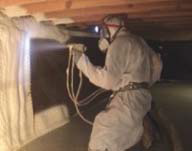Pilot Program
GHI PILOT PROGRAM
Updated January 2015
PROGRAM SUMMARY
The GHI Buildings Committee was created in the Fall of 2008 to “advise the Board on matters related to maintenance, repair and improvement programs for existing GHI buildings and acquisition of new buildings.” The Board asked the Buildings Committee to develop a program to improve energy efficiency and comfort in the homes. One of the first of these activities was to develop a set of goals for the creation of a plan for replacing the electric baseboard heaters and for making improvements to the “building envelopes” (i.e. the “skin” of the house including such components as roof, siding, doors, the surface above the crawl spaces, etc.) The goals for such capital improvements are the following:
- reduce overall energy consumption and costs in the dwelling units;
- improve member comfort and “livability”;
- emphasize use of sustainable, environmentally friendly energy sources, technologies, and products where economically feasible;
- reduce overall life cycle costs, including preventive and corrective maintenance, for heating, cooling and domestic hot water systems;
- minimize disruption to households as improvements are being made; and
- implement the program while maintaining the unique and historic character of the GHI homes.
The Buildings Committee then created a Pilot Program which began in the Fall of 2010 to determine what additional improvements would be possible to implement. The Pilot Program was designed to provide GHI with information on the actual cost of energy efficiency upgrades, the energy savings they will bring, the payback periods for the upgrades, and the impact on members while the work is being done. The Pilot Program is vital to helping GHI in making the best choices for energy efficiency upgrades, because computer models and expert reports cannot tell us the whole story.
There are 28 units (7 rows) in the Pilot Program, consisting of 3 rows of block units, two of frame, and two of brick façade units. Members in these units agreed to participate in the Pilot after they were contacted by GHI because their rows and met certain criteria for the Pilot Program. The Pilot Program consists of three phases. In each phase, GHI is being assisted by the Home Innovation Research Labs (formerly the National Association of Home Builders - Research Center). Through a grant from the Department of Energy, the Home Innovation Research Labs provide technical assistance at no charge to GHI members by assisting with design of the Pilot Program so that it delivers informative results.
PHASE ONE
BEGAN: November 2010
Goal: Measurements will provide a baseline of data that will be used to determine the impact of alternative energy efficiency improvements made to the pilot homes during phases 2 and 3.
SUMMARY: The Home Innovation Research Labs performed energy audits on the Pilot homes to determine where the homes were losing heat in winter and where cold air was infiltrating into the homes. The Home Innovation Research Labs also installed temperature and humidity sensors in the pilot units as well as special electric meters on baseboard heaters, water heaters, and clothes dryers. During Phase 1 and continuing through the next two phases, measurements of temperature and humidity in different rooms are being recorded. Year 1 measurements are providing a baseline of data that will be used to determine the impact of alternative energy efficiency improvements made to the pilot homes during phases 2 and 3.
Reports:
Phase 1 Report 1
Phase 1 Report 2
Phase 1 Report 2 Appendices
Phase 1 Report 3
STATUS: Completed
PHASE TWO
BEGAN: November 2011
GOAL: Step one, increase insulation of crawl spaces. Step two, insulate attics, replace windows and doors, install bathroom exhaust fans and new vinyl siding and insulation on the block and
 |
frame units.
SUMMARY: This Phase consists of two steps. In the first phase, starting in November 2011, the crawl spaces of the pilot homes were insulated. Measuring devices will record temperature and humidity information that will help the Home Innovation Research Labs determine the impact that the crawl space insulation had on lowering home energy use for heating and cooling.
The second step of Phase 2 includes insulation of attics, replacement of windows and doors, installation of bathroom exhaust fans and new vinyl siding and insulation on the block and frame pilot units. Measuring equipment will indicate the impact these improvements make on member comfort and unit energy costs.
BLOCK UNIT DETAILS: Vinyl siding and insulation are being tested on some of the block units. In addition, the Home Innovation Research Labs will provide us with information on the cost, energy savings, and disruption to members, of insulating the block units on the interior instead of using an exterior insulation strategy.
STATUS: Step One is completed; Step Two was completed in December 2013.
Report:
Phase 2 Interim Report
Phase 2 Report 2
PHASE THREE
 |
Goal: Determine the most efficient heating system for GHI homes.
SUMMARY: Several alternative heating systems may be installed and tested. Those systems have not been determined at present. The information from Phase 2 measurements will assist the Buildings Committee to recommend appropriately-sized heating systems, since we will know the increase in member comfort and reduction in winter heating costs that result from the envelope upgrades themselves.
RESULTS
Based on the results of the Pilot Program, the Buildings Committee will draft its recommendations for GHI-wide upgrades to the membership and the GHI Board. The GHI Finance Committee will explore ways for the co-op to finance and pay for Phase 3 of the pilot program and for the entire GHI community upgrade. Read more about the Community Upgrade.
STAY INFORMED
Sign up to receive emails from the Buildings Committee about work on this project by emailing Jim Cohen at jimcohen@umd.edu. The Board and Buildings Committee will continue to keep members up-to-date about the Pilot Program through a variety of means (the News Review, on the GHI website, the Communicator, by special mailings, etc.). Also, the Buildings Committee meets on the 4th Wednesday of each month, beginning at 7:00 p.m. in the board room at the GHI Administration Bldg. We welcome your participation in these meetings.
For more information about the Pilot Program and the Community Upgrade, please contact:
- Steve Skolnik, Board of Directors liaison to the Buildings Committee: sdskolnik@gmail.com
- Jim Cohen, Chair of the Buildings Committee: 301-345-0472, jimcohen@umd.edu
Please help us spread the word by talking to your neighbors and friends in the community. If you have ideas for the Board or the Buildings Committee, please contact the people listed above.
Additional Links:




